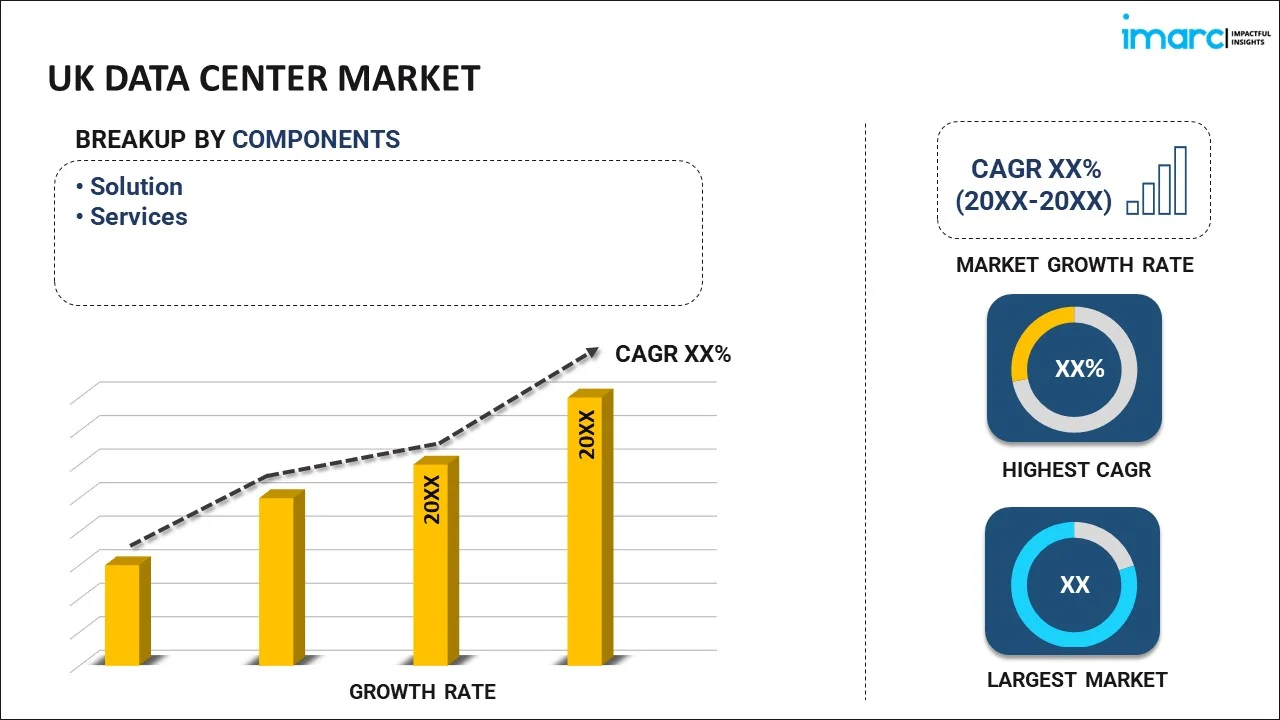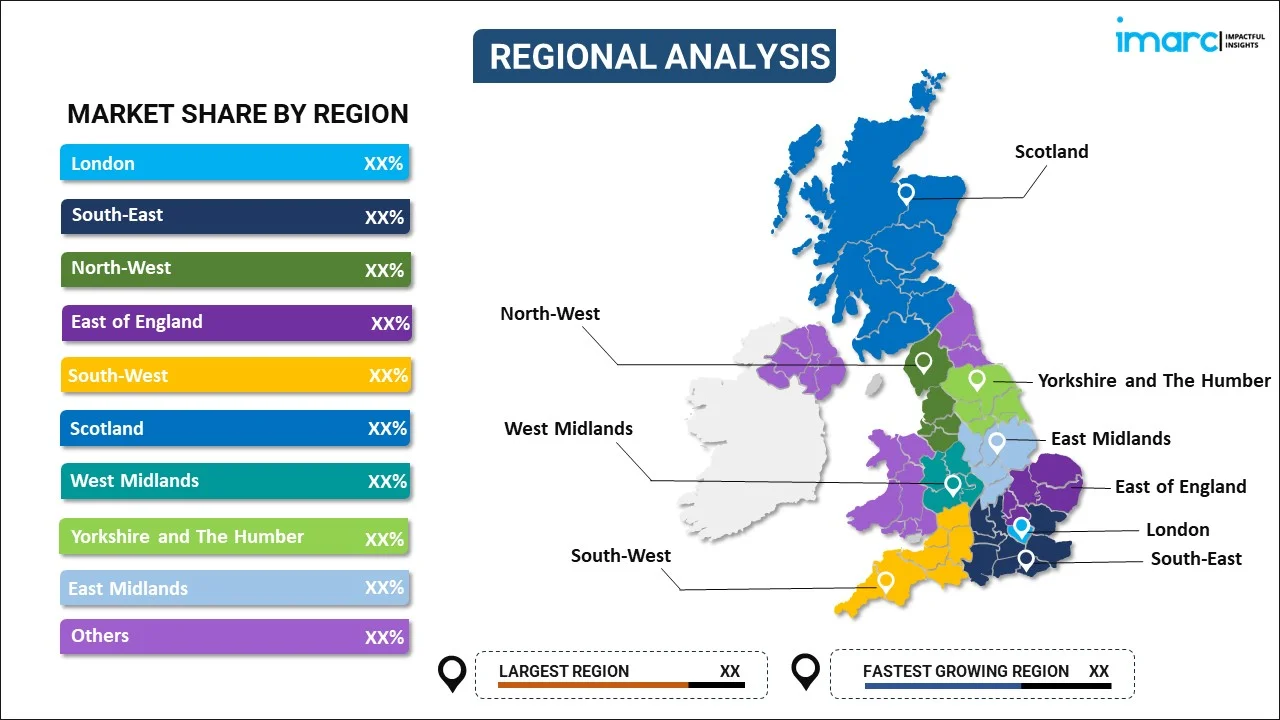
UK Data Center Market Report by Component (Solution, Services), Type (Colocation, Hyperscale, Edge, and Others), Enterprise Size (Large Enterprises, Small and Medium Enterprises), End User (BFSI, IT and Telecom, Government, Energy and Utilities, and Others), and Region 2024-2032
UK Data Center Market Overview:
The UK data center market is projected to exhibit a growth rate (CAGR) of 6.20% during 2024-2032. The increasing smartphone penetration rate, enhancing demand for data storage and processing capability, and the introduction of 5G services represent some of the key factors driving the growth of the market.
|
Report Attribute
|
Key Statistics
|
|---|---|
|
Base Year
|
2023 |
|
Forecast Years
|
2024-2032
|
|
Historical Years
|
2018-2023
|
| Market Growth Rate (2024-2032) | 6.20% |
UK Data Center Market Trends:
Increasing Smartphone Penetration Rate
One of the key factors boosting the growth of the UK data center market is the rising number of population using smartphone in the country. For instance, in UK, mobile phones accounted for almost 46% of the electronic device market in October 2023, compared to just under 50% for desktop computers and less than 5% for tablets. Since they became more widely available in the UK, the smartphone penetration rate has increased year-on-year, reaching 92% in 2021. Crafters also feel that the demand for data storage and processing capability increases as more consumers consume content and shop through their smartphones. This increased use of data requires the creation and improvement of data canters to provide quality and fast connection, faster access to the content, and in general, comfortable work, which, in turn, is contributing to the progress of the market. For instance, in January 2024, Google announced that it would be investing $1bn (£0.79bn) in a new data center in Hertfordshire. Microsoft also stated that it will be investing some of its £2.5bn around Cardiff and possibly in the Nort-west.
Emergence of 5G Services
The introduction of 5G services is the major factor accelerating the UK data center market. For instance, delivering the speedy rollout of 5G standalone across the country could be worth as much as £7.4bn in additional economic value by 2030 compared to a slower rollout, according to research from Vodafone. With 5G providing far faster data rates and reduced delay, high capacity, and low latency data processing and storage are increasingly in demand. The demand for data canters is high due to usage for 5G networks, internet of things, smart city, real time applications and, hence driving the market. The UK data center market is experiencing steady growth and investment. Despite its status as a large, mature market, growth of 36% was predicted between 2021 and 2025. Research and development (R&D) on next generation 5G and 6G wireless technology and telecoms security is to be ramped up as part of a £110 million government investment in the UK.
UK Data Center Market News:
- In May 2024, Equinix, Inc., one of the world's biggest digital infrastructure company, announced the availability of Dell PowerStore on Equinix Metal, a new, enterprise-grade Storage as a Service (STaaS) solution. Dell PowerStore on Equinix Metal with flexible configurations can help enterprises manage a wide range of high-performance multicloud workloads through low-latency connectivity with proximity to major public clouds.
- In March 2024, NTT DATA, a leading global IT infrastructure and services company, announced that its Global Data Centers division will develop and operate its third data center campus in Berlin, a key Tier 2 data center market in Europe. This addition is part of NTT DATA’s global expansion efforts to meet a growing demand for data usage and computation, with over $10 billion in data center growth projected for fiscal years 2023-27 across key markets around the globe.
UK Data Center Market Segmentation:
IMARC Group provides an analysis of the key trends in each segment of the market, along with forecasts at the country level for 2024-2032. Our report has categorized the market based on component, type, enterprise size, and end user.
Component Insights:

- Solution
- Services
The report has provided a detailed breakup and analysis of the market based on the component. This includes solution and service.
Type Insights:
- Colocation
- Hyperscale
- Edge
- Others
A detailed breakup and analysis of the market based on the type have also been provided in the report. This includes colocation, hyperscale, edge, and others.
Enterprise Size Insights:
- Large Enterprises
- Small and Medium Enterprises
The report has provided a detailed breakup and analysis of the market based on the enterprise size. This includes large enterprises and small and medium enterprises.
End User Insights:
- BFSI
- IT and Telecom
- Government
- Energy and Utilities
- Others
A detailed breakup and analysis of the market based on the end user have also been provided in the report. This includes BFSI, IT and telecom, government, energy and utilities, and others.
Regional Insights:

- London
- South East
- North West
- East of England
- South West
- Scotland
- West Midlands
- Yorkshire and The Humber
- East Midlands
- Others
The report has also provided a comprehensive analysis of all the major regional markets, which include London, South East, North West, East of England, South West, Scotland, West Midlands, Yorkshire and The Humber, East Midlands, and Others.
Competitive Landscape:
The market research report has also provided a comprehensive analysis of the competitive landscape in the market. Competitive analysis such as market structure, key player positioning, top winning strategies, competitive dashboard, and company evaluation quadrant has been covered in the report. Also, detailed profiles of all major companies have been provided.
UK Data Center Market Report Coverage:
| Report Features | Details |
|---|---|
| Base Year of the Analysis | 2023 |
| Historical Period | 2018-2023 |
| Forecast Period | 2024-2032 |
| Units | xx |
| Scope of the Report | Exploration of Historical Trends and Market Outlook, Industry Catalysts and Challenges, Segment-Wise Historical and Future Market Assessment:
|
| Components Covered | Solution, Services |
| Types Covered | Colocation, Hyperscale, Edge, Others |
| Enterprise Sizes Covered | Large Enterprises, Small and Medium Enterprises |
| End Users Covered | BFSI, IT and Telecom, Government, Energy and Utilities, Others |
| Regions Covered | London, South East, North West, East of England, South West, Scotland, West Midlands, Yorkshire and The Humber, East Midlands, Others |
| Customization Scope | 10% Free Customization |
| Post-Sale Analyst Support | 10-12 Weeks |
| Delivery Format | PDF and Excel through Email (We can also provide the editable version of the report in PPT/Word format on special request) |
Key Questions Answered in This Report:
- How has the UK data center market performed so far and how will it perform in the coming years?
- What has been the impact of COVID-19 on the UK data center market?
- What is the breakup of the UK data center market on the basis of component?
- What is the breakup of the UK data center market on the basis of type?
- What is the breakup of the UK data center market on the basis of enterprise size?
- What is the breakup of the UK data center market on the basis of end user?
- What are the various stages in the value chain of the UK data center market?
- What are the key driving factors and challenges in the UK data center?
- What is the structure of the UK data center market and who are the key players?
- What is the degree of competition in the UK data center market?
Key Benefits for Stakeholders:
- IMARC’s industry report offers a comprehensive quantitative analysis of various market segments, historical and current market trends, market forecasts, and dynamics of the UK data center market from 2018-2032.
- The research report provides the latest information on the market drivers, challenges, and opportunities in the UK data center market.
- Porter's five forces analysis assist stakeholders in assessing the impact of new entrants, competitive rivalry, supplier power, buyer power, and the threat of substitution. It helps stakeholders to analyze the level of competition within the UK data center industry and its attractiveness.
- Competitive landscape allows stakeholders to understand their competitive environment and provides an insight into the current positions of key players in the market.
Need more help?
- Speak to our experienced analysts for insights on the current market scenarios.
- Include additional segments and countries to customize the report as per your requirement.
- Gain an unparalleled competitive advantage in your domain by understanding how to utilize the report and positively impacting your operations and revenue.
- For further assistance, please connect with our analysts.
 Inquire Before Buying
Inquire Before Buying
 Speak to an Analyst
Speak to an Analyst
 Request Brochure
Request Brochure
 Request Customization
Request Customization




.webp)




.webp)












